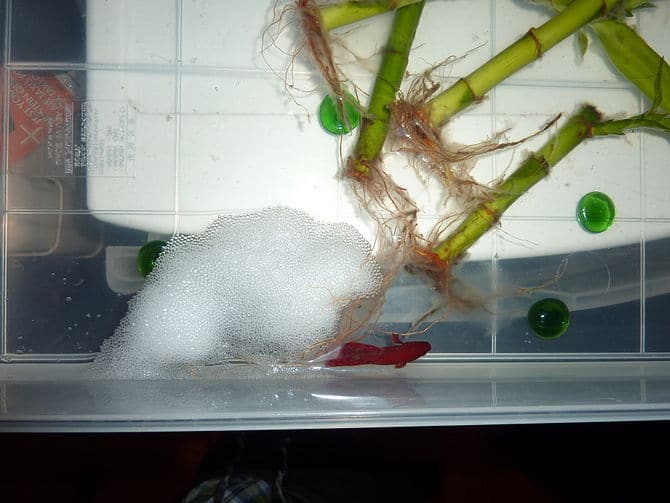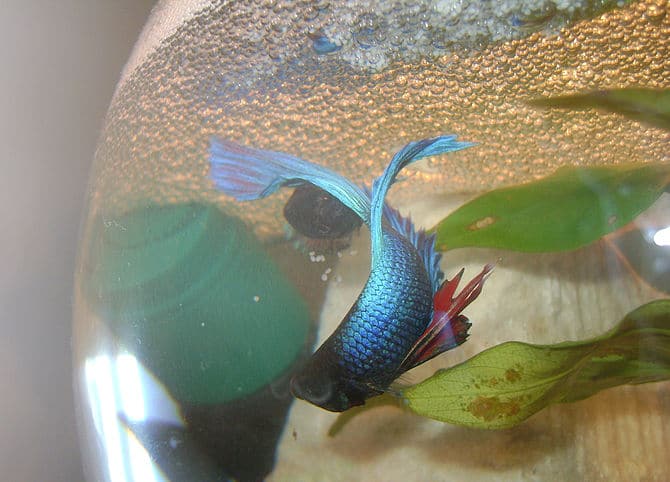Betta Fish Facts
Betta fish are fresh water, small fish that are part of the Osphronemidae family. Betta fish come in approximately 65 species, with the most popular one being betta splendens, or also called Siamese Fighting Fish. For hundreds of years, the species has been selectively and extensively bred in order to improve its fighting abilities and to enhance its appearance as far as its tail and fin configurations, color combinations and color.
What colors are bettas?

English: Betta Splendens fish with his bubblenest just prior to a water change. (Photo credit: Wikipedia)
Wild betta are normally fairly dull in color. They are usually dull green and brown. The main colors of cultivated bettas are green, blue and red. However,as a result of selective breeding, bettas are now available in a wide variety of colors, that range from opaque white to black and everything in between, including purple, turquoise, green, blue, red, orange and yellow. There are even bettas in metallic hues like platinum, silver and gold as well as neon colors. Some bettas are solid colors, while others display incredible color combinations.
What are the various kinds of bettas?
Usually betta fish that have been raised in captivity are distinguished and known based on the specific shape of their fins and tails. The most common kinds of betta fish are the Veil Tail, Rose Tail, Plakat, Half-Sun, Half-Moon, Fin Tail, Double Tail, Delta Tail, Crown Tail and Comb Tail.
Are all bettas fighters?
As previously mentioned, not all bettas are fighters. The betta that hobbyists favor the most, the betta splendens, definitely is a fighting fish. Therefore, people tend to assume automatically that all bettas are fighters. However, the species called betta imbellis, is a peaceful type of fish. It isn’t aggressive and does well with other tranquil species in an aquarium.
Why does the betta splendens species fight?
Betta males are very aggressive towards one another and highly territorial. In addition, fighting other males is part of their mating ritual; with males fighting for the right to mate with a certain female.
How long do betta fish live?

A pair of Betta splendens spawning in an aquarium. The beautifully colored male (below) has started to retrieve some of the sinking eggs, and will spit them into the bubble nest on the surface. After the spawning he guards the nest until the roe hatch and the fries’ yolk sacs are fully absorbed. The female take no part in the caring of the eggs or young fry. (Photo credit: Wikipedia)
In general, bettas live 2 to 6 years. It depends on how they are cared for. The norm is 2 to 3 years, with 4 to 6 years considered to be quite good. Some individuals give anabolic steroids to their bettas to increase their life span further. The quality of care and food provide to the betta factors into their longevity, as do exercise and space.
How large do betta fish get?
Bettas are a small type of fish. They range in size from under 1 inch up to 5 inches in length. Size usually depends on what species the betta is. The average size of the betta spledens, or Siamese fighting fish, is approximately 2.5 inches, with 4 inches considered to be giant.
What type of food do bettas eat?
Bettas in the wild are carnivores, and feed on carrion, shrimp, insect larvae, insects and small worms. You can feed betas kept in tanks mosquito larvae, daphnia, blood worms, brine shrimp and freeze-dried or frozen beef heart. For pet bettas, there are also small, round pellets and floating flakes that are available. There are comprised of a combination of minerals, vitamins, wheat flour, mashed up fish or shrimp and other ingredients. However, it is recommended to give live food to your pet bettas one or two times per week.
How often should bettas be fed?
Bettas aren’t huge eaters. They can be fed once per day, but only feed them as much foot as they consume in two minutes. Don’t feed them one day per week to give them the chance to clean out their systems.
Betta fish diseases.
Yes, bettas do get sick at times. Fortunately, they usually recover if they are treated early enough. It is very important to closely observe your bettas so that you can become familiar with their habits. That way, if there is a change in their routine or appearance, you can quickly spot it. Most betta fish diseases result in poor water conditions like rapid temperature fluctuations and dirty water. Sometimes bad organisms get introduced into the water when dirty equipment or new fish are put into the tank. Fortunately there are precautionary measures that can be taken in order to help prevent some of the more common diseases that betta fish get.
How can I keep my betta healthy?
The first preventive step you should take is to keep the water in the tank clean. Aquarium salt should be added to the water. Don’t allow any uneaten food to rot in the water. Any equipment you place in the water should be sterilized. Also, before dipping your hands in the tank, wash them first. Before introducing new fish into the tank, quarantine them first. Keep the water temperature at 85 degrees F and avoid having any abrupt fluctuations in water temperature.
